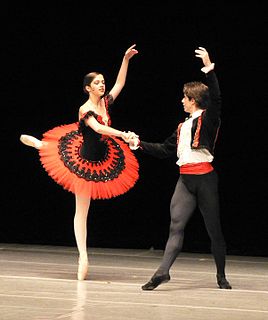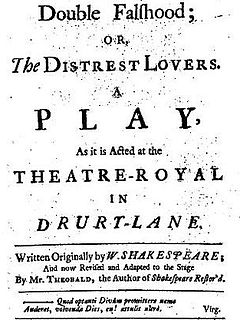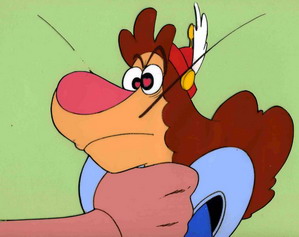 W
WThe Adventures of Don Coyote and Sancho Panda is a 1990 American/Italian animated television series produced by Hanna-Barbera with the Italian public service broadcaster RAI and its first channel Rai 1, loosely based on the main characters in Miguel de Cervantes' 17th century novel, Don Quixote: Don Quixote himself and Sancho Panza.
 W
WCamino Real is a 1953 play by Tennessee Williams. In the introduction to the Penguin edition of the play, Williams directs the reader to use the Anglicized pronunciation "Cá-mino Réal." The play takes its title from its setting, alluded to El Camino Real, a dead-end place in a Spanish-speaking town surrounded by desert with sporadic transportation to the outside world. It is described by Williams as "nothing more nor less than my conception of the time and the world I live in."
 W
WDon Quixote is a ballet in 3 acts, based on episodes taken from the famous novel Don Quixote de la Mancha by Miguel de Cervantes. It was originally choreographed by Marius Petipa to the music of Ludwig Minkus and first presented by the Ballet of the Imperial Bolshoi Theatre of Moscow, Russia on 26 December [O.S. 14 December] 1869. Petipa and Minkus revised the ballet into a far more expanded and elaborated edition in five acts and eleven scenes for the Imperial Ballet, first presented on 21 November [O.S. 9 November] 1871 at the Imperial Bolshoi Kamenny Theatre of St. Petersburg.
 W
WDon Quixote is a 1976 sculpture by Aurelio Teno located at the northeast corner of the Kennedy Center in Washington, D.C. The sculpture of Don Quixote and his horse Rocinante was a gift from Spain for the United States Bicentennial.
 W
WDon Quixote is a 1955 sketch by Pablo Picasso of the Spanish literary hero and his sidekick, Sancho Panza. It was featured on the August 18–24 issue of the French weekly journal Les Lettres Françaises in celebration of the 350th anniversary of the first part, published in 1605, of the Miguel de Cervantes novel Don Quixote. Made on August 10, 1955, the drawing Don Quixote was in a very different style than Picasso’s earlier Blue, Rose, and Cubist periods.
 W
WDouble Falsehood or The Distrest Lovers is a 1727 play by the English writer and playwright Lewis Theobald, although the authorship has been contested ever since the play was first published, with some scholars considering that it may have been written by John Fletcher and William Shakespeare. Some authors believe that it may be an adaptation of a lost play by Shakespeare and Fletcher known as Cardenio. Theobald himself claimed his version was based on three manuscripts of an unnamed lost play by Shakespeare.
 W
WFasana-e-Azad, sometimes spelled Fasana-i-Azad, is an Urdu novel by Ratan Nath Dhar Sarshar. It was serialized in Avadh Akhbar between 1878 and 1883 before it was published in four large volumes by the Nawal Kishore Press. The story follows a wandering character named Azad and his companion, Khoji, from the streets of late-nineteenth-century Lucknow to the battlefields of the Russo-Turkish War (1877–1878) in Constantinople and Russia. The work's status as a novel has been debated, but it is thought by most scholars to be one of the first novels in Urdu.
 W
WThe Female Quixote; or, The Adventures of Arabella is a novel written by Charlotte Lennox imitating and parodying the ideas of Miguel de Cervantes' Don Quixote. Published in 1752, two years after she wrote her first novel, The Life of Harriot Stuart, it was her best-known and most-celebrated work. It was approved by both Henry Fielding and Samuel Richardson, applauded by Samuel Johnson, and used as a model by Jane Austen for Northanger Abbey. It has been called a burlesque, "satirical harlequinade", and a depiction of the real power of females. While some dismissed Arabella as a coquette who simply used romance as a tool, Scott Paul Gordon said that she "exercises immense power without any consciousness of doing so". Norma Clarke has ranked it with Clarissa, Tom Jones and Roderick Random as one of the "defining texts in the development of the novel in the eighteenth century".
 W
WAlonso Fernández de Avellaneda is the pseudonym of a man who wrote a sequel to Cervantes' Don Quixote. The identity of Avellaneda has been the subject of many theories, but there is no consensus on who he was. It is not clear that Cervantes knew who Avellaneda was although he knew that it was a pseudonym and that the volume's publication information was false. One theory holds that Avellaneda’s work was a collaboration by friends of Lope de Vega. Another theory is that it was by Gerónimo de Passamonte, the real-life inspiration for the character Ginés de Pasamonte of Part I.
 W
WGoodman Beaver is a fictional character who appears in comics created by American cartoonist Harvey Kurtzman. Goodman is a naive and optimistic Candide-like character, oblivious to the corruption and degeneration around him, and whose stories were vehicles for social satire and pop culture parody. Except for the character's first appearance, which Kurtzman did alone, the stories were written by Kurtzman and drawn by Will Elder.
 W
WJoseph Andrews, or The History of the Adventures of Joseph Andrews and of his Friend Mr. Abraham Adams, was the first published full-length novel of the English author Henry Fielding, and among the first novels in the English language. Published in 1742 and defined by Fielding as a "comic epic poem in prose", it is the story of a good-natured footman's adventures on the road home from London with his friend and mentor, the absent-minded parson Abraham Adams.
 W
WMan of La Mancha is a 1965 musical with a book by Dale Wasserman, music by Mitch Leigh, and lyrics by Joe Darion. It is adapted from Wasserman's non-musical 1959 teleplay I, Don Quixote, which was in turn inspired by Miguel de Cervantes and his 17th-century novel Don Quixote. It tells the story of the "mad" knight Don Quixote as a play within a play, performed by Cervantes and his fellow prisoners as he awaits a hearing with the Spanish Inquisition. The work is not and does not pretend to be a faithful rendition of either Cervantes' life or Don Quixote. Wasserman complained repeatedly about people taking the work as a musical version of Don Quixote.
 W
WThe Miguel de Cervantes Memorial by Joseph Jacinto Mora is located in Golden Gate Park in San Francisco, California.
 W
WMonsignor Quixote is a novel by Graham Greene, published in 1982. The book is a pastiche of the classic 1605 and 1615 Spanish novel Don Quixote by Miguel de Cervantes with many moments of comedy, but also offers reflection on matters such as life after a dictatorship, Communism, and the Catholic faith.
 W
WQuichotte is a 2019 novel by Salman Rushdie. It is his fourteenth novel, published on 29 August 2019 by Jonathan Cape in the United Kingdom and Penguin Books India in India. It was published in the United States on 3 September 2019 by Random House. Inspired by Miguel de Cervantes' classic novel Don Quixote, Quichotte is a metafiction that tells the story of an addled Indian American man who travels across America in pursuit of a celebrity television host with whom he has become obsessed.
 W
WThe Shadow Dragons, released on October 27, 2009, is the fourth novel of The Chronicles of the Imaginarium Geographica, a book series begun by Here, There Be Dragons. It was preceded by The Indigo King and followed by The Dragon's Apprentice.
 W
WSilverlock is a novel by John Myers Myers published in 1949. The novel's settings and characters, aside from the protagonist, are all drawn from history, mythology, and other works of literature.
 W
WSuper Don Quix-ote (スーパードンキホーテ) is a laserdisc video game released by Universal in 1984. In it, the player controls the knight Don as he attempts to rescue a princess from an evil witch.
 W
WZukkoke Knight - Don De La Mancha is a Japanese anime television series based on Miguel de Cervantes' Don Quixote. The 23-episode series was directed by Kunihiko Yuyama and was first broadcast on Tokyo Channel 12 in 1980.